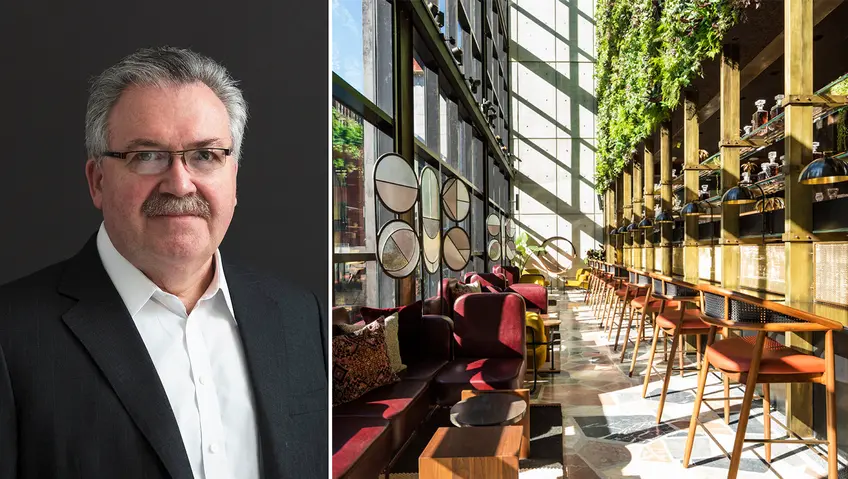 Paul Taylor, president of Stonehill Taylor, and the firm's recently-finished Moxy Chelsea Hotel in the flower district (All images courtesy of Stonehill Taylor)
Paul Taylor, president of Stonehill Taylor, and the firm's recently-finished Moxy Chelsea Hotel in the flower district (All images courtesy of Stonehill Taylor)
Paul D. Taylor is a master storyteller. That might not be how he would introduce himself, as he would most likely use the title of president of hotel design firm Stonehill Taylor, but every building Taylor designs begins with a detailed narrative. It is that specific narrative that develops through the building’s design and is the tie from start to finish that weaves all of the people, ideas, concepts, and functions of each project from conception to sales. Stonehill Taylor’s most notable projects span new hotel buildings and conversion of iconic historic properties, including high-profile hotels around the country, like the super suave JFK TWA Hotel, uber-hip Moxy hotels, like Moxy Chelsea and Moxy Times Square, the path-breaking NoMad Hotels NYC and Las Vegas and so many more (Park Terrace Hotel in the Bryant, Moxy Downtown, InterContinental Barclay, JW Marriott Nashville, and the Eliza Jane Hotel in New Orleans, to name a few).
CityRealty had the privilege of speaking to Taylor to discover how he develops specific narratives, how hotels' stories in the same brand differ, how New York City hotels differ from anywhere else in the world, and what he, as an experienced and skilled hospitality architect, notices first the minute he enters a new hotel.
CityRealty had the privilege of speaking to Taylor to discover how he develops specific narratives, how hotels' stories in the same brand differ, how New York City hotels differ from anywhere else in the world, and what he, as an experienced and skilled hospitality architect, notices first the minute he enters a new hotel.
''Every project has a geographic, historical, and cultural context. Our team’s first step in the process is to not only do a significant amount of research but also spend ample time on-site truly experiencing the property and its surroundings." — Paul Taylor
How do you create the narratives for your projects? Can you explain the process? Can you compare some of your hotels’ specific narratives and design goals and they may be similar and different?
Our approach for our projects is to always have a narrative, as it is important to have something that anchors what you are going to design. So, instead of saying, “I love this and it’s great looking,” a narrative creates meaning which is not only a helpful tool in developing the design, but also in providing our clients a pitch that can help sell the design in the future. We’ve noticed that for some of our projects, the operations people actually share that story when they interact with guests.
In creating a narrative, the context is a good place to start. Every project has a geographic, historical, and cultural context. Our team’s first step in the process is to not only do a significant amount of research but also spend ample time on-site truly experiencing the property and its surroundings. Our goal is to create a unique design that feels relevant and of the place. However, it’s important to note that when you execute the narrative, you do not want it to be too literal.
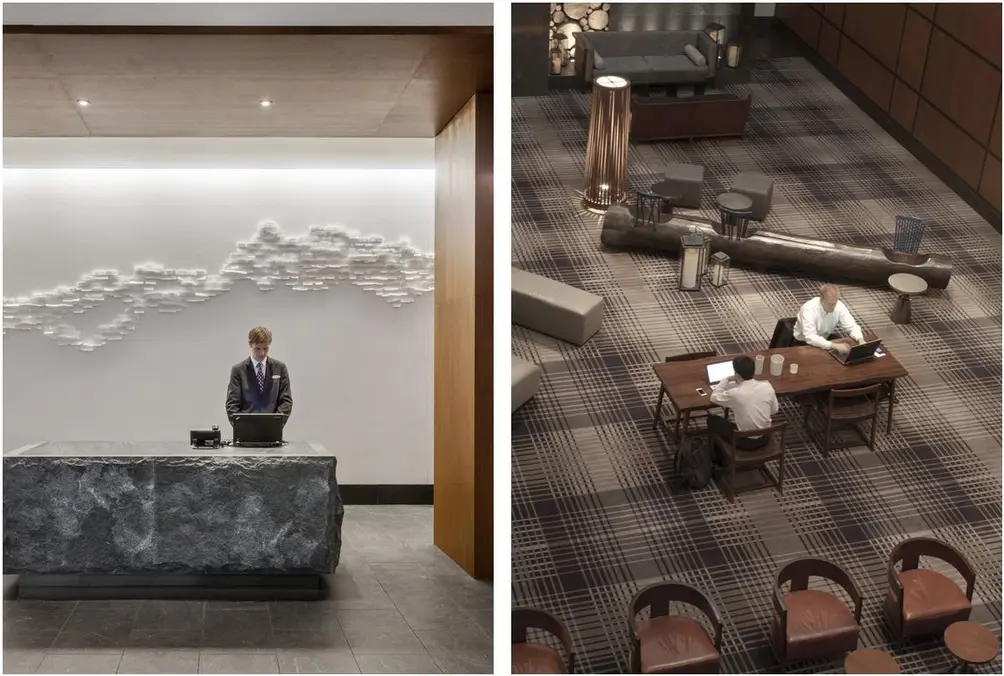 Hyatt Regency Minneapolis (courtesy of Stonehill Taylor)
Hyatt Regency Minneapolis (courtesy of Stonehill Taylor)
The Hyatt Regency in Minneapolis is a great example of where the history of Minneapolis played a major role in our design. We wanted to pay homage to the city’s role as an epicenter of American manufacturing and industry, as well as innovation and progressive arts and cultures. We were able to source 80% of our materials and furnishings from within 500 miles of the site, and we partnered up with a number of local artists and producers to create pieces completely unique to Minneapolis. For example, we worked with the company 3M, headquartered in Minneapolis, to create a 60-foot map of the Minnesota and Mississippi Rivers made solely of Post-Its, one of the city’s most famous inventions, to go behind the reception desk. It’s a subtle nod to location and forces guests to look a bit closer.
Another great case in point is the work we did and continue to do for Moxy in contextualizing the New York City experience for the brand’s more millennial consumer base. In hospitality design understanding the customer’s desires for travel and experiences are the key to successful projects.
When you are working in the same city, are your narratives similar?
Objectively we like each project to have its own narrative. We are working on a total of eight Moxy hotels, with five in Manhattan, which is why we look to the rich heritage in each site’s neighborhood to create the project narratives.
With the Chelsea Moxy, the architecture was inspired by the dichotomy that exists within the surrounding Flower District, the charm of greenery spilling out of the gritty warehouse-style buildings. In the new hotel, industrial and natural elements come together to create a welcoming destination with a unique NYC aesthetic. The most striking feature of the building is the juxtaposition between the exposed concrete walls and the greenhouse-like facade in front of the structure’s concrete core. Oxidized CorTen steel columns and large gridded windows give the building a retro-factory aesthetic and a compelling transparency. Greenery running down the interior walls is visible through the glass façade which provides a distinct architectural element of the building.
We had zoning restrictions that required the building had to go up to 85 feet before you can set back. We used this requirement as an opportunity to design the ground floors in reference to the Flower District and create a greenhouse at the entrance of the hotel. Airplane hangar doors enclose the entire street frontage and can fully retract to the ceiling, opening the first floor to the sidewalk and connecting to the community and street life of the neighborhood.
When you are working with one hotel, like Nomad or Moxy, in different locations, what do you hold common and what do you alter?
The original NoMad Hotel here in New York was a renovation of a striking Beaux-Arts building with great bones. Prior to the transformation, it was being used as an office building and the retail was underutilized. Our objective through the design narrative was to have the building give off the ambiance that it had always been a grand hotel. We collaborated closely with French designer Jacques Garcia who was inspired by a Parisian flat with Opulent ambiance and dark accents.
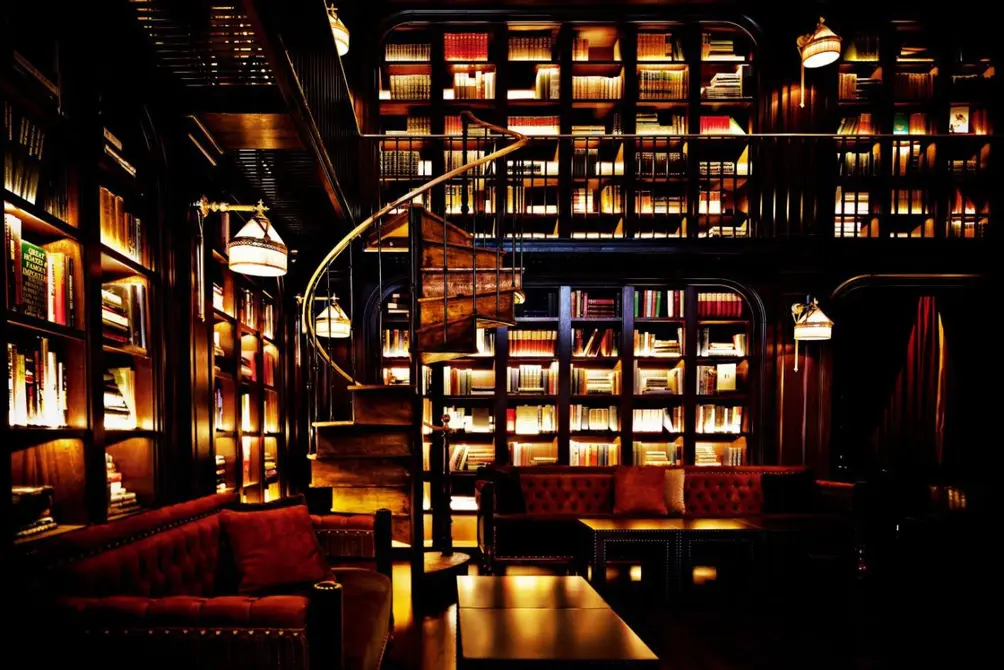 NoMad Hotel, New York's library loung.
NoMad Hotel, New York's library loung.
With this project, we wanted to instill a bit of Paris in New York and because of the demographic here, the hotel evolved into a hip romantic enclave that took on the best of both cities. Guest rooms have bathrooms with tubs by the windows, and the design is nontraditional while using traditional materials. Although the floors look historic, we did not restore existing flooring but instead had to cover the concrete floors with reclaimed wood from South Carolina. We essentially fabricated a stage set that feels real, but for a grand hotel that never was.
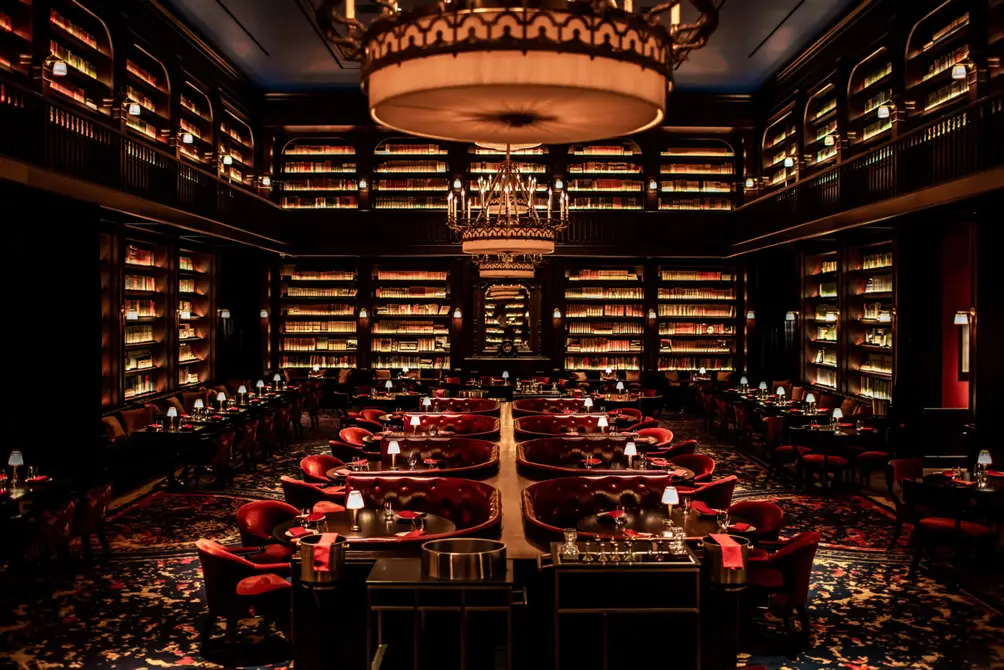 The NoMad Las Vegas, inspired by New York's, but
The NoMad Las Vegas, inspired by New York's, but
In contrast, we just did the NoMad Las Vegas roll out, which was a much larger project than the original. In New York, we created an intimate hotel that was in the heart of the city. Las Vegas provided us with more freedom and space to create something bigger and grander than before. Where the library at the Nomad in New York is a quaint charming space, the Las Vegas location was the transformation of an old sports gambling casino with double-height ceilings and it delivers quite a wow factor.
Do NYC hotels have any specific needs that hotels in other places do not have?
New York City hotels have tremendous design requirements because the cost of real estate here is unbelievably high, the availability of building sites rare and everyone picks over them. There are always new zoning restrictions and a need to get special permits. But however arcane NYC’s zoning regulations are, we appreciate them because it is our specialty. Hospitality design in New York is very specific to this city because of the limited space. For this reason, you may have a smaller, well-designed room and larger, well thought out public spaces.
Can you tell us a bit about 159 Broadway in Williamsburg?
Our project at 159 Broadway is interesting as it is right at the entrance to Brooklyn on the Williamsburg Bridge and will be the first thing that people see when arriving. Additionally, the site is adjacent to the historic, former Williamsburg Savings Bank, which is now an event space. 159 Broadway will be a mixed-use tower including a 277-foot concrete base topped with a glass cube which will become 235 hotel rooms and 21 condos. The project will be completed by 2021 and become a marker at one of the gateways to the borough from the city.
What was it like working on the amazing TWA Hotel?
It was a once in a lifetime experience to work on the TWA Hotel. This is arguably one of the most iconic buildings in the city designed by one of the most talented contemporary architects Eero Saarinen. We were so lucky to have an enthusiastic client Tyler Morse, of MORSE Development whose incredible vision for the project was contagious to the many hardworking teams involved.
We served as the exclusive interior designer for the 512 guestrooms, housed in the two newly built wings designed by executive architect Beyer Blinder Belle and Lubrano Ciavarra. In addition to guestroom design, our scope included the interior design for the Sunken Lounge, fitness center, retail, and the Connie cocktail bar within a restored Constellation airplane.
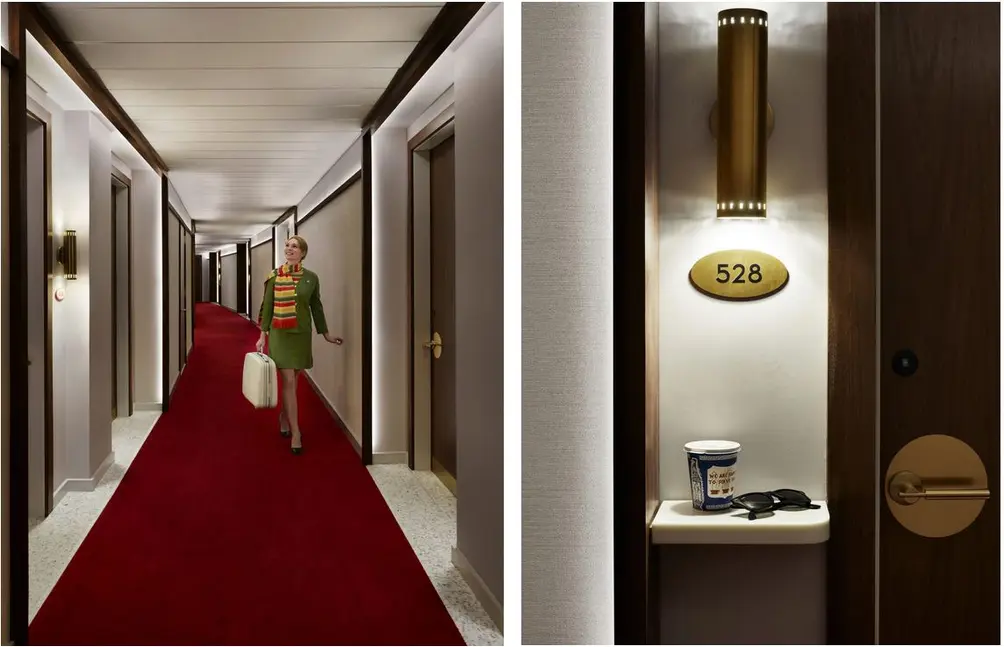 TWA Hotel common spaces
TWA Hotel common spaces
Our team used the original flight center opened in 1962 as their main source of inspiration. 1962 in many ways signified American strength, optimism, and innovation: Aviation was the promise of the future. We took the meaning of the year 1962 to envision a contemporary guest experience, intuitive and refined, in communication with Saarinen’s work. By offering a modern refuge with a strong sense of design and space, the rooms are meant to make guests feel the same appreciation and excitement for aviation that travelers once felt during the rise of the industry.
We designed the project as if Saarinen was there as a partner. It was incredible to not only to be part of the team designing this unique hotel but to experience it after it was complete was really wonderful.
Since you’re such a master at designing hospitality, what are the first things you notice when checking into a hotel that someone else designed?
What I notice when first walking into a hotel is the lobby and the arrival experience. The lobby used to be just a place that you walked through and now it’s a place to be. You no longer go straight to the reception and then to your room; now, the lobby itself is part of the experience. It’s interesting to see how other firms have been able to create an inviting atmosphere that feels more like a destination.

Contributing Writer
Michelle Sinclair Colman
Michelle writes children's books and also writes articles about architecture, design and real estate. Those two passions came together in Michelle's first children's book, "Urban Babies Wear Black." Michelle has a Master's degree in Sociology from the University of Minnesota and a Master's degree in the Cities Program from the London School of Economics.

 6sqft delivers the latest on real estate, architecture, and design, straight from New York City.
6sqft delivers the latest on real estate, architecture, and design, straight from New York City.
